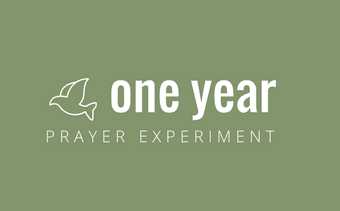Over the course of this year-long experiment, I plan to experience many different forms of prayer. I look forward to trying new ways of meeting with the Lord.
The first form of prayer I am going to experiment with will, however, seem rather mundane. The first form of prayer I am going to practice is simply going to be regular, daily prayer.
I am not currently in the habit of praying daily. I will send up a short distress call when I am stressed, or I may send up a wish list when I want something. But daily prayer that has no other goal than relationally connecting to God is not currently a part of my life. Step one it seems, is simply to start praying, and start the process of making it a habit.
Discipline Required
A healthy dose of self-discipline is going to be required since daily prayer is not already a habit. I think of people who want to lose weight and get in shape. It is really no secret what it takes to accomplish this. A person simply needs to eat fewer calories and exercise more. We could spend hours figuring out what exactly that looks like in our lives and create detailed plans for our fitness journey.

But, nothing about our health will change until we actually start eating less and exercising more. Lasting change will only come about when these two things are done regularly. Making this a part of our lives, especially in the beginning, may not feel natural. It may not even be fun. Over time, momentum will build and it will become easier. It will become fun. A habit will be formed.
The habit will not form, however, without good old self-discipline. I wish I could spiritualize it for us. Create some kind of formula we could work through that would instantly change our desires and make this feel natural – or more “spiritual.” But that is just not how it is.
Make it Easier on Ourselves
So, we need to be disciplined to create a habit of prayer. At some point we need to make the decision to pray and then just do it. We would be prudent however, to help ourselves out and make the process as easy on us as we can. There are two significant strategies we can use to make this process easier.
Pick a Regular Time
There is a major difference between saying, “I will work out more” and saying, “I will work out on Monday, Wednesday, and Thursday at 5 AM for 30 minutes.” One statement is a wish. The other statement is a plan.
For a prayer life to become a habit we need a plan. We will never “just have” or “just find” time for meaningful prayer. We must plan it into our lives by intentionally setting aside a regular time everyday to do nothing but pray.
 Stop and think about your schedule and routines. Try to find a time in which you are consistently free. We must find a time when we do not regularly have appointments, phone calls, or other pressing responsibilities. You must be available to pray. Make sure this time we are trying to set aside will be a time when other events won’t spill over into your time. This is the classic problem with lunch time prayer. Long meetings, working lunches, or similar things often push lunch around. Make sure to find a time that will not be subject to the intrusion of other events.
Stop and think about your schedule and routines. Try to find a time in which you are consistently free. We must find a time when we do not regularly have appointments, phone calls, or other pressing responsibilities. You must be available to pray. Make sure this time we are trying to set aside will be a time when other events won’t spill over into your time. This is the classic problem with lunch time prayer. Long meetings, working lunches, or similar things often push lunch around. Make sure to find a time that will not be subject to the intrusion of other events.
Also, make sure to pick out a time when you can truly be “disengaged from your day.” This means we are able to stop our mind from running in a thousand directions and are able set aside the to-do list long enough to focus on talking with our Father. I have found it difficult when I am in work mode to slow down my mind enough to thoughtfully engage in prayer. It has been equally difficult for me spin my mind back up to work speed some days after I pray.
Be aware of how your mind works and how your day flows. Pick out a time and if you need to, write it in your calendar.
Pick a Regular Place
The second part of a successful prayer plan is to pick a regular place to pray. Just like a consistent time will make forming a habit of prayer easier, so will having a consistent place.
An ideal place to pray will have several characteristics. All of them involve reducing distraction. The first characteristic of a great place to pray is that it is a place where you can be alone.

Whether they intend to or not, people can be a distraction. With just their presence, people can force us to be relationally “on,” meaning we are diverting attention towards them to be able to respond to them if the need arises. Being by ourselves allows us to completely focus on God.
The second characteristic of a great place to pray is that it is quiet. This one sounds obvious, but it bears repeating. Trying to formulate a praise to God while taking heads debate the news on TV is going to be tough. Resisting the urge to sing along with the radio makes it hard to listen for God’s guidance. A place of quiet is a place free from distraction.
A third characteristic of a great place to pray is that the place is not inherently stressful to you. This is a more subjective trait and will vary from person to person. But in essence, if being in a place causes you stress, it will be prudent to find a different place to pray. For example, don’t pray in a playroom cluttered with toys if the mess stresses you out. Or, don’t pray at your desk if you are unable to temporarily put out of your mind the pile of work sitting in front of you.
Removing the Biggest Distraction of All
 Our cell phones are amazing tools. They allow incredible amounts of productivity and connectivity. Our phones are also incredible distractions. With constants ringing and alerts, they demand constant attention. In addition, the ability to respond almost instantly seems to have created the expectation that we react almost instantly to anything our phone alerts us to. In the pursuit of a distraction free environment, I will challenge all of us to put the phones away while we pray. Turn it off. Leave it in the other room. We are on a more important call.
Our cell phones are amazing tools. They allow incredible amounts of productivity and connectivity. Our phones are also incredible distractions. With constants ringing and alerts, they demand constant attention. In addition, the ability to respond almost instantly seems to have created the expectation that we react almost instantly to anything our phone alerts us to. In the pursuit of a distraction free environment, I will challenge all of us to put the phones away while we pray. Turn it off. Leave it in the other room. We are on a more important call.
What (I Hope) Works for Me
For me, the time that works best is going to be in the morning. I currently wake up early in the morning and work out in my garage. When I begin the experiment, I will get up a little earlier, perform my workout, and then settle down and pray for 30 minutes.
This time meets all the criteria for me. I am consistently free at 5:30 am. Meetings or appointments never happen this early for me. The phone is not ringing and the work emails are not rolling in yet. The kids are all still asleep. It is quiet, and I can be free from distraction.
Some of you might ask why I don’t pray first, then work out? If prayer is so important – a priority – it seems that I should pray first, and then work out. The answer goes back to knowing how my mind works. My mind does not wake up so fast in the morning. I have tried praying first thing in the morning in the past. What usually happens is that after I crawl out of bed and go find a place to be still and quiet, my mind just wants to go back to sleep. So, often after trying to pray in the morning I would be double frustrated. First, I was frustrated because I did not actually spend 30 minutes connecting to God, I just wasted 30 minutes trying to stay awake. Secondly, I accomplished nothing, and gave up 30 minutes of sleep. I had neither slept nor connected to God. Lose, lose situation.
What I have found, however, is that if I get up and do a short workout, it wakes my mind and my body. The grogginess is gone. My mind is fresh and alert. I am able to focus on God and give Him my full attention. So, I work out first and then pray second because it works for me. It may take a few tries, but with a little effort, we will all find what works for us.

For me, the place to pray is going to be in the garage. It meets all the criteria. In the morning I have the garage all to myself. I have tried to come inside in the mornings,
but our youngest is a light sleeper. There is no distraction free prayer if there is a four-year-old boy awake and wanting to play. So, I will simply stay in the garage after I work out.
The garage is also quiet in the mornings. And it is a place free of inherent stress. The garage is my place to pray.
Be Adaptable
It is vital to remind ourselves as we try to pick a time and place to pray to not get married to our first chosen time and place. There is no Biblically correct time and place to pray. We are simply commanded to pray. The time and place are flexible and they are up to us.
Pick a time and place. Give it a good try of at least a week. After a week of consistently praying at the same time and place, we will know if it is working for us or not. Be honest in our analysis. If our chosen time and place are not working because we are simply being undisciplined and not doing it – that is not the fault of the time or the place. Keep at it.
We may, however, after a good try, find that our chosen time and place are not working for us. If that is the case, reassess and pick a new time and place to pray. The answer is not always try harder. The point of choosing a time and place is to make it easier for us to pray. As you can tell from my experience, I have tried several different times and places in the past.
Keep trying until you find a time and place that works for you. Then stick with it. Until it doesn’t. Then pick a new time and place. Life happens. Circumstances change. Just keep adapting. Just keep praying.
How I Will Pray
To start my fledgling daily prayer habit, I am going to start by praying in the way I wrote about in my post “How to Pray.”
In that post, we read the well-known Lord’s Prayer from Matthew 6:9-13 and learned that Jesus was teaching us the essential components of a balanced and healthy prayer life: praise, justice & unity, requests & thanks, confession, and protection from the enemy.
It is challenging, and instructive, to see how asking for things is only one part of proper prayer. According to this outline, only one-fifth of my time in prayer should be spent running through my list. I’ll bet that praying this way will be a lot more relational.
I am exited to start and find out.
Check out our PDF guide on choosing a time and place to place pray on our Toolbox Page.
It is a simple one-page guide that you can print out and use to help you when you are off line.



Recent Comments